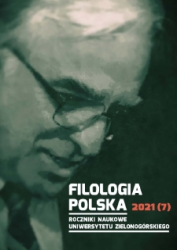Good or beautiful? Bad or ugly? Polish-Italian moral-aesthetic dilemmas
Keywords
Abstract
Probably in all languages, the basic criteria for assessing people, things or phenomena are aesthetic (nice/ugly) and moral (good/bad) criteria. However, the terms belonging to these two categories alternate, expressing more generally positive or negative assessments. No wonder certain phenomena described as “pretty” in some languages will be considered “good” in others or expressed in terms of other adjectives – and vice versa. The same is true for negative evaluations. This article aims to present this linguistic phenomenon based on two languages, Polish and Italian. This analysis can be helpful for teachers and translators, as it is easy to assume that the target language evaluates phenomena with the same adjectives as we use in our mother tongue.
References
Słowniki
Devoto G., Oli G.C., Il Devotino. Vocabolario della lingua italiana con CD-Rom, Varese 2012.
[Google Scholar]
Doroszewski W., Słownik języka polskiego PWN, online: [sjp.pwn.pl].
[Google Scholar]
Doroszewski W., Słownik poprawnej polszczyzny PWN, Warszawa 1978.
[Google Scholar]
Il Nuovo Zingarelli. Vocabolario della lingua italiana di Nicola Zingarelli, red. M. Dogliotti, L. Rosiello, wyd. 11, Bologna 1986.
[Google Scholar]
Słownik języka polskiego PWN, online: [sjp.pwn.pl].
[Google Scholar]
Słownik języka włoskiego, online: [www.treccani.it].
[Google Scholar]
Stoppelli P., I Garzantini. Dizionario italiano, Garzanti 2000.
[Google Scholar]
Opracowania
Dargenio M., Analisi contrastiva degli errori più spesso commessi da studenti di italiano madrelingua polacca, „Educazione Linguistica” 2016, Vol. 5, Num. 2.
[Google Scholar]
Kreisberg A., Problemi dell’analisi lessicale nell’ottica glottodidattica, „Studi Slavici” 2004, (I).
[Google Scholar]
Kwapisz-Osadnik K., Podstawowe wiadomości z gramatyki polskiej i włoskiej, Katowice 2012.
[Google Scholar]
[1672]
Preview
Downloads
Published
How to Cite
Issue
Section
Categories
Copyright & License

This work is licensed under a Creative Commons Attribution-NonCommercial-NoDerivatives 4.0 International License.
Copyrights (a). In principle, authors who are not employed by the University of Zielona Góra retain the copyright, including publishing rights to the articles, without restrictions.
Copyrights (b). In principle, authors who are employed by the University of Zielona Góra, do not retain the copyright, including publishing rights to the articles. In such cases the copyright holder is the University of Zielona Góra.
Print ISSN
2450-3584-
Abstract148











































